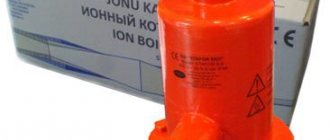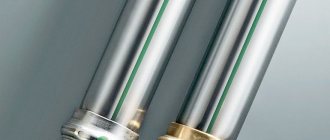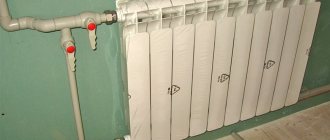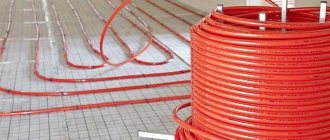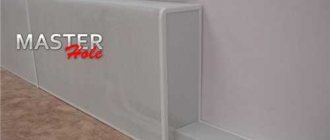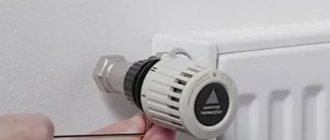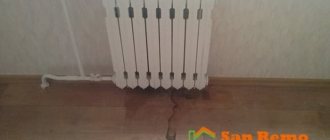Not so long ago, only smooth-walled pipes were used in heating systems. Thanks to the active development of technology, new materials are emerging that are used in the installation of heating systems. One of them is a metal corrugated pipe for heating.
The peculiarity of the product is that it gets flexibility from corrugation, and strength from stainless steel. Therefore, such products are becoming increasingly common in modern heating systems. Let's get acquainted with the features, advantages and disadvantages of the pipe and pay attention to what you need to consider when choosing.
Why is corrugation a good option for heating?
Stainless steel corrugation began to be used for heating systems not so long ago, but has already gained popularity due to its unique technical and operational characteristics.
Advantages and disadvantages:
The advantages can be safely attributed to:
- wide range of operating temperatures. Corrugated pipes can be operated with coolant temperatures in the range -50ºС to +110ºС without loss of their original properties;
- resistance to strong pressure surges within the network. Stainless steel products have a large margin of safety in terms of pressure, as they can withstand up to 50 bar. In heating systems at a maximum circulating temperature of +110ºС, the pressure level usually does not exceed 15 Bar;
- high elasticity. Pipes are easily bent without the use of special tools. They can be given any shape (bending radius is 30 - 150 mm depending on the diameter of the pipes), which allows you to assemble the wiring with a minimum number of fittings, thus reducing the overall cost of the heating system;
- unusually high resistance to corrosion. The corrugated pipe does not collapse under the influence of moisture, its internal walls are not subject to the formation of limescale deposits that reduce the throughput of pipelines;
- durability. The service life of corrugated stainless steel pipes is practically unlimited; the service life of the heating system can only be affected by a violation of the integrity of the fittings, the service life of which does not exceed 30 years;
- smooth inner surface of the walls. Corrugated pipes have a smooth surface on the inside, creating minimal resistance to the movement of the coolant and ensuring noiselessness;
- maintainability. If necessary, you can easily replace only a section of a corrugated pipe or a device that has failed;
- the ability to compensate for linear expansion due to the corrugated structure, which is especially important when installing a “warm floor”;
- frost resistance. Stainless steel corrugation is not afraid of defrosting; if water freezes in it, the pipe simply expands, and in the future it can be warmed up with a blowtorch.
Like any other product, flexible heating pipes have some disadvantages:
- low impact resistance. When installing sections of the heating system in places where there is a risk of mechanical damage, it is recommended to protect the corrugated stainless steel pipe with a metal or polymer box;
- difficult care. Cleaning corrugated pipes from dust is somewhat more difficult than pipes with a smooth surface. When cleaning, you will have to use a brush, and it is best to immediately cover the corrugated structures with a protective casing or screen;
- specific appearance. Many people do not consider the corrugated surface of products to be aesthetically pleasing enough, but if you use a hidden installation method, then this drawback becomes insignificant;
- impossibility of concreting inside the wall. To connect to heating devices, special fittings are used, to which free access must be provided for inspection and maintenance;
- high electrical conductivity, so a grounding device and installation of dielectric gaskets are necessary.
Scope of application
The excellent performance qualities of corrugated pipes allow it to be used equally effectively in a variety of areas of the national economy:
- industry;
- agricultural enterprises;
- food production;
- chemical and pharmacological enterprises.
But corrugated stainless steel has won true popular love thanks to the ability to quickly and efficiently install any pipeline in an apartment or private house. The flexibility and versatility of corrugated materials are especially valuable in the cramped conditions of city apartments, where literally every centimeter of space can count.
We recommend that you read: What is and rules for installing a coaxial chimney for a boiler
There are often cases when communications have to be completely redone due to the fact that a few millimeters of pipe were missing during installation. A flexible corrugated pipe can always be laid in such a way that its length is exactly as long as necessary.
Corrugation is produced in standard coils of 50 meters, which makes it easy to install even the largest structures. If necessary, you can order pipes of any size and length from the manufacturer.
Note! The scope of application of corrugated pipes is not limited to water supply or heating systems. A hollow and flexible steel pipe will serve as excellent protection against moisture, rodents and mechanical damage for electrical cables.
Alternatives
In addition to stainless steel, plastic or cast iron (products with a ribbed surface) are used to make corrugated pipes. Plastic products are not the best option for heating, where the operating temperature of the coolant can reach +110ºС, since they can function normally only at temperatures up to +85ºС and a pressure in the system of no more than 20 atmospheres.
Cast iron finned pipes are characterized by high resistance to thermal loads, but they are gradually falling out of mass use due to their high weight, low impact resistance and complex installation process.
Description
First, a short description.
Pipe material is stainless steel containing at least 17% chromium. The wall thickness is only 0.3 mm, which reduces the material consumption of production and, accordingly, the cost of production. The small wall thickness is compensated by corrugation, which increases the ring rigidity and tensile strength of the pipe, and also makes it extremely flexible.
The thickness of the pipe walls is a third of a millimeter
Characteristics
Here are the characteristics of corrugated stainless steel according to one of the leading manufacturers - the Lavita company.
| Parameter | Meaning |
| Operating pressure | 15 kgf/cm2 |
| Breaking pressure | 210 kgf/cm2 |
| Working temperature | Up to 150°C |
| Service life of pipes and fittings | Is not limited |
Note: the manufacturer sets service life limits only for silicone seals in fittings. These rings need to be replaced after 30 years of service.
The silicone seal lasts 30 years, the pipe and fitting last indefinitely
How are corrugated pipes made from stainless steel?
The technical conditions for the manufacture of corrugated pipes regulate the use of AISI 304 stainless steel.
It is produced using the following technology:
- the stainless steel sheet enters the forming machine, where it takes on a cylindrical shape;
- the edges of the cylinder are welded together by laser, plasma or induction current;
- the strength of the weld is checked by eddy currents;
- then the workpiece undergoes calibration, during which the product acquires a characteristic wavy structure;
- When leaving the calibrating machine, cutting to the required length is carried out.
Such a pipe can already be used for installation, but it is less durable and ductile. To increase these indicators, products are subjected to heat treatment (firing) at a temperature of +600ºС, followed by a period of forced cooling (tempering).
Visually, the products are no different, but after firing they become stronger and more flexible, which means that when bent, creases will not form on them, as on unmolded corrugation.
Manufacturers and what to look for when purchasing
The bulk of stainless steel corrugations are produced in South Korea by the following companies:
- Lavita is a manufacturer of corrugated stainless steel pipes for heating in the mid-market price segment. There are complaints about the strength characteristics of the walls: when installing fittings, there is a danger of damaging the stainless steel, which subsequently causes leaks. However, this drawback is most likely the result of illiterate installation.
- Corrugated stainless steel pipes for heating from this company are considered the best among similar products. It’s true that their price is several times higher than the cost of corrugations from the previous manufacturer. These models are connected with fittings equipped with thicker O-rings, which provides a more reliable connection.
- Hydrost products are comparable in price to pipes from Lavito, but these products often have factory defects. Leaks at fitting installation sites occur on average in 7% of systems assembled from these pipes.
- Quite high-quality products, but their cost is considered unreasonably high.
When purchasing a corrugated product, you should visually inspect its surface for damage, creases and deformations. The distance between the ridges should be the same size along the entire length of the pipe.
It is also necessary to familiarize yourself with the certificate of conformity, which will confirm the quality and allow you to avoid buying handicraft fakes.
Additional selection criteria depend on the type of corrugation:
- numbered length. The pipe must have a complete set of fittings;
- arbitrary length. It is necessary to check the quality of the cutting line. The edges should be smooth and free of burrs.
Production technology
High-precision technology is used to create stainless steel corrugations. The pipes are made of alloy steel; the high content of nickel and chromium provides the coating with anti-corrosion qualities.
The technology includes several stages:
- installation on equipment of the required sizes and configurations;
- cutting elements and connecting them;
- creating a corrugated surface;
- package.
The structure is created from steel sheets, pipes of a given configuration are formed using special devices. The edges of the elements are joined by welding. The quality of connections is checked with a laser device.
Which corrugation is better?
Lavita is a manufacturer of corrugated stainless steel pipes for heating in the mid-market price segment. However, this product has complaints from consumers regarding the strength characteristics of the walls: when installing fittings, there is a danger of damaging the stainless steel, which subsequently causes leaks. However, this drawback is most likely the result of illiterate installation.
Hydrosta's products are comparable in price to pipes from Lavita, but often have factory defects. Leaks at fitting installation sites occur on average in 7% of systems assembled from these pipes.
The products of the Meibes company are quite high quality, but their cost is considered unreasonably high.
Corrugated stainless steel pipes for heating Kofulso are considered the best among similar products. It’s true that their price is several times higher than the cost of corrugations from the previous manufacturer. These models are connected with fittings equipped with thicker O-rings, which provides a more reliable connection.
What product shortcomings should we not forget?
- The downside is the high price - this is a controversial issue, since the material itself is not cheap, plus a unique manufacturing technology. The low price of such a thing should alert you, most likely it is a fake. When making a purchase, check the integrity of the packaging - there are markings on it, there are no inscriptions on the pipe.
- Another feature manifests itself during operation and saddens housewives: dust accumulates in the depressions of the pipe, which is difficult to wash out.
- The products are afraid of external mechanical damage; special screens will provide protection.
- The disadvantages of the connections include the fact that the fittings require regular maintenance.
- If part of the heating system is located in an open room, additional insulation is required to avoid heat loss.
- Twisting is not allowed.
- There is a possibility of corrosion caused by electrochemical processes (grounding saves).
Dimensions and approximate prices
Corrugated pipes in diameters of 15, 20, 25 and 32 mm are produced for the distribution of radiator heating systems and “warm floors”.
Price per 1 running meter different for all manufacturers. For example, an annealed corrugated pipe made of Kofulso stainless steel is sold at the price:
- DN 15 mm - 172 rubles;
- DN 20 mm - 320 rub.;
- DN 25 mm - 399 RUR;
- DN 32 mm - 766 rub.
Rules for choosing a corrugated stainless steel pipe for a heating system
To choose flexible pipes for heating, you need to check the reliability of the supplier. Counterfeiting of products is irrelevant, since the manufacturing process is complex, but there is a risk of buying a product with a manufacturing defect. The basic rule of choice is the absence of visible defects and damage to the pipeline. If, after bending, the segment does not return to its previous position, the pipe is defective.
Advice! It is important to decide on the length of the section; there is no point in buying extra meters, since the pipe is only suitable for forming short sections of the heating system.
To calculate the volume of coolant to fill the system, you need to know the diameter of the corrugated product.
Standard parameters:
Types of plastic pipes for heating and their characteristics
- A corrugation with a cross-section of 15 mm has a linear meter area of 0.064652 m2. The volume of circulating coolant is 0.22 l.
- A corrugation of 20 mm Ø with an area of one linear meter of 0.0954004 m2 supports the circulation of coolant in a volume of 0.45 liters.
- A pipe 25 mm Ø with an area of 0.121394 m2 per 1 linear meter requires 0.71 liters of coolant for circulation.
- With a cross-section of 32 mm and an area of 0.15218 m2, 0.98 liters of coolant water is needed per linear meter.
When calculating coolant volumes, the total length of the pipeline must be taken into account.
Connection methods
To connect stainless steel corrugated pipes, a brass compression fitting with a silicone or rubber O-ring is used. The end of the pipe is inserted into it until it stops and tightened with a ring.
When switching from a smooth steel pipe to a corrugated one, the fitting is first attached to the smooth pipe, and then a stainless corrugated pipe is inserted into it.
Flexible radiator connection
A manual rolling machine is used to make flexible hoses for radiators and heaters.
First, a piece of pipe of the required length is cut with a pipe cutter or grinder, and the cut line is carefully cleaned. The pipe is then inserted into the protruding flaring machine onto two corrugated rings to allow the protruding edge to be flared using a hammer. Next, a union nut with a rubber gasket is put on this end of the pipe. Attaching the union nut to the other end is done in the same way.
Warm floor
For laying corrugated pipes in a “warm floor” system, it is recommended to use plastic clips as fastening elements.
Holes for dowels for attaching clamps must be drilled through the insulation layer into the concrete screed.
Installation should begin from the distribution cabinet, connecting one end to the manifold outlet. Next, the pipe is rolled out of the coil and placed between the clips in coils, the distance between which should be 30 cm and at least 20 cm from the walls. After the pipe is evenly distributed throughout the room, its second end is connected to the outlet of the return collector.
Results
Judging by the reviews, the picture is even too rosy: no one is complaining. This is even a little alarming. But maybe it’s just that not much time has passed: they began to actively install stainless corrugated pipes for heating just a few years ago and the “sides” have not yet come out. Although, if there were serious problems, they would have already manifested themselves, and negative messages would definitely appear: a person is more inclined to describe why he does not like the product than to write about problem-free operation.
Whether or not to install stainless steel corrugation for heating is up to everyone to decide for themselves, but everything looks quite attractive: prices, characteristics and ease of installation. Even the reviews are encouraging.
Reviews and operating experience
The appearance of corrugated stainless steel on sale is estimated at several years, so there is not much operating experience with it. Reviews on forums are only positive from those who have installed such systems at home, and some negative from specialists who claim that such products have higher resistance to coolant flow. However, none of those who installed a heating system using such pipes required the installation of a more powerful circulation pump. Basically, such a system is connected in houses to a wall-mounted gas boiler and includes the usual wiring from heating devices and “warm floors”.
Regarding quality, Kofulso products deserve more positive reviews than products from other brands.
Specifications
According to the standards, metal corrugated culverts do not lose their functional characteristics at temperatures of -50... +110°C.
The pipes are also resistant to pressure changes. The average value reaches 50 atm; higher quality products can withstand short-term exposure to up to 210 atm.
The corrugated structure provides plasticity to the products, which does not lead to deformation and a decrease in water flow. In accordance with the diameter indicators, the bending radius varies from 25 to 150 mm. When bent, the pipes do not deform, do not break, and retain their structure.
The standard thermal conductivity characteristics of corrugated pipes are about 17 W/m*K. The average roughness coefficient of the coating reaches 0.008 n, this indicator indicates a low level of siltation of pipelines.
Common pipeline diameters range from 1.5 to 3.2 mm. Models with a diameter of up to 1 mm are optimal for transporting various substances in enterprises. Pipes are produced to order in the sizes required for the construction project.
The technical characteristics of the products ensure simple installation of pipes with connecting fittings selected by diameter.
